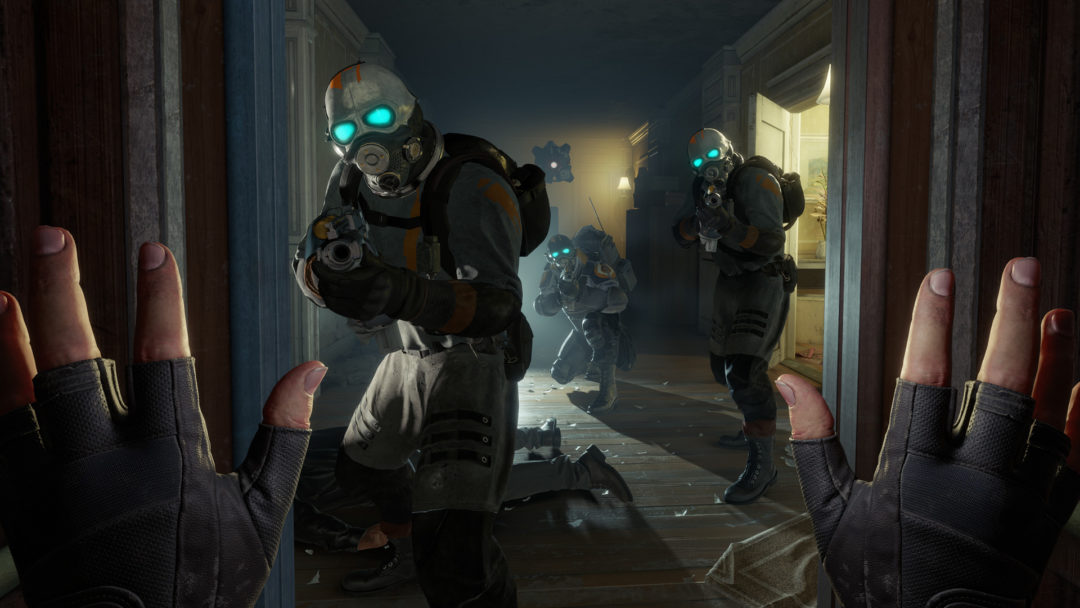Something strange has been happening to us this month. Valve has been talking to us. “Us” meaning the games press — the writers and content creators who run around nipping at the heels of every publisher and developer in reach, hoping that they’ll say something juicy whenever we get them to yelp or whack us with a newspaper.
As a writer looking at the company from the outside, Valve has seemed like a silent, enigmatic monolith for the past nine years. But there I was, on a Skype call with developer Sean Vanaman and level designer Corey Peters talking about the company and VR adventure Half-Life: Alyx, and they answered just about any question I could come up with in the time they had available. They were even so kind as to tell me why they were willing to subject themselves to my fumbling, nervous questions.
“It’s been a long time since we’ve made a game like this,” said Vanaman. “It’s a triple-A game launch, so you launch it like a triple-A game. You get out, you talk to people about it.”
The reason why Valve is usually reticent about its games, Vanaman said, is their games’ identities cannot not be set in stone in advance, particularly with the various multiplayer titles. They’re all community experiences, and the games’ communities would mold the game into something that Valve could not hope to predict.
“I could have never imagined that Dota is what it is today, or (Team Fortress),” said Vanaman. “It’s sort of hard to get out in front of those things and be like, ‘Here’s our big plan.’ It doesn’t matter. You have to wait until the customers tell you what the plan should be.”
In 2018, Valve announced that they were ready to start publishing games again and released the CCG Artifact a few months later. This wasn’t a sudden change in policy, though — Half-Life: Alyx had been in development since 2016.
“We kinda started Half Life: Alyx probably about three-and-a-half… I think it’s almost fully four years ago now,” Peters said.
So why didn’t they say anything? Well… they were busy working, really.
“We didn’t have a lot to talk about. During game development, your head’s down. You’re working in the mind, so to speak. You’re building a product. You’re learning. You’re trying to figure out what this game is going to be,” said Peters. “There’s not a lot to go and talk about yet. A lot of our quietness is just us working.”
When you’re making the next Half Life game, and making a game that will introduce plenty of players to the world of VR gaming, you need to take the time to make sure you get everything right.
“A lot of the things that make Half-Life work, such as exploration, puzzle-solving, pacing around combat and storytelling — they just fit really well with the VR experience,” Peters said.
But no matter how well the ideas fit, creating a triple-A VR game required them to consider things that never really mattered in game development before.

“I mean, the height of the player matters!” said Vanaman. “If there’s a barrier in the way, literally someone who’s under five feet tall — we’ve had to take all of these things into consideration.”
Every unique challenge had to be overcome through experimentation and playtesting. Lots of playtesting.
“I always heard that Valve does a lot of playtesting before I came to work here, and I was not prepared for the amount of playtesting this company does,” admitted Vanaman.
The hard work all started to pay off in November 2019, when Valve finally announced the upcoming release of Half Life: Alyx — the first Half-Life game to come out in over 12 years. From that point on, the hype train was moving forward at full force. The team is far more comfortable with promoting Half-Life: Alyx compared to all the other games they’ve released in the past decade because they have a far better handle on what it is, exactly.
“With this game, it’s a crafted experience from start to finish, so we know what to say about it,” said Vanaman.
The initial announcement came from the official Valve Twitter account — notable, because this Twitter account didn’t even exist until a few months before the announcement.
Half-Life: Alyx. Now Available. https://t.co/NCOLWqSp3e pic.twitter.com/uHAHmSVdXg
— Valve (@valvesoftware) March 23, 2020
“It was an opportunity to realize, ‘Oh, you know, we actually don’t have a big umbrella account. This is going to be a big deal online,’” said Vanaman. “We don’t think about it like broad initiatives. We don’t get into a big strat plan meeting and think about, ‘How are we going to leverage social media over the next few years?’”
And so, they’ve been talking. They’ve been answering questions about their design philosophy, their development history, their experiences throughout the game’s creation, and their hopes for how people would react — something that they admit they were worried about. Some at the company thought that the announcement would be a huge success, while others worried that fans would be furious that the next Half-Life game would be a VR title.
“That’s something we couldn’t test. We couldn’t test what that announcement response was going to be like,” said Vanaman.
Of course, Valve mentioned back in 2017 that three VR games were in the works. The mathematically inclined may note that this is more games than the current one that they’re willing to talk about.
I asked whether we’d be getting the same sort of full-force media treatment when those other games see the light of day. It was then that I remembered I was still talking to Valve, and they’re not going to talk about things until they’re good and ready.
“Anything else that we do in the future is going to be its own thing,” said Vanaman. “We’re going to do what we think is going to excite customers the best, and that’s pretty much it — what’s right for the product, and what’s going to get customers the most excited about the thing that we’re excited about.”
So, any news about what’s coming next will come when Valve is ready to spill the beans — and the beans will be spilled exactly when, and how, Valve wants them to be spilled.






Published: Mar 23, 2020 01:32 pm